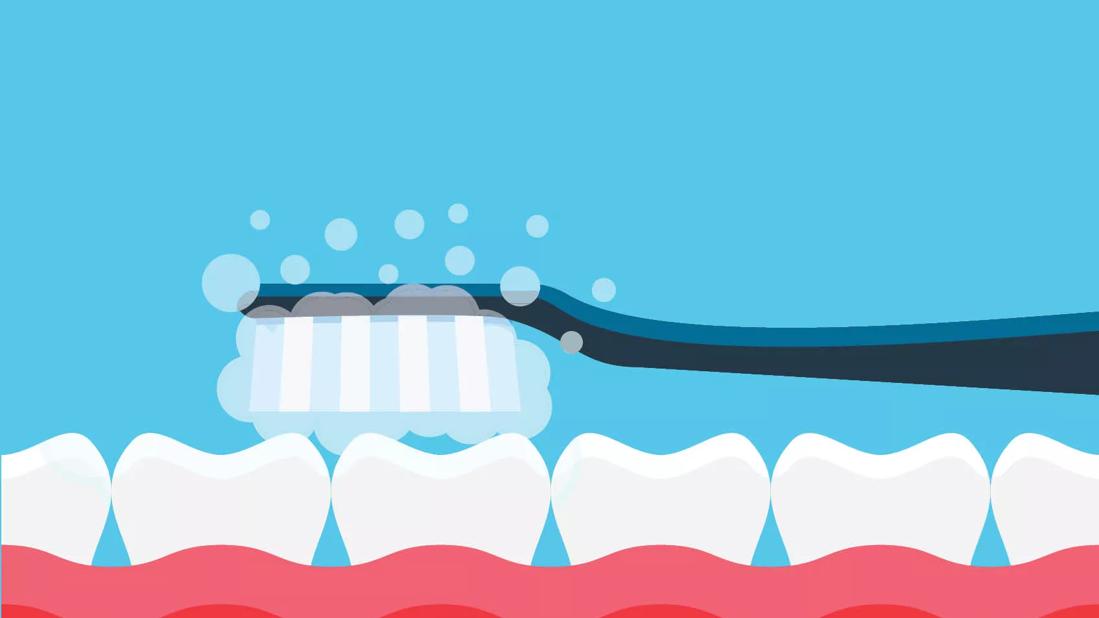Brushing for two minutes, twice a day is your baseline for dental health

From an early age, most of us learned to brush our teeth twice a day. Regular brushing is a great start to optimal dental health — but it’s not enough to keep your mouth in tip-top shape even if you follow that one simple rule. Dentist Anne Clemons, DMD, explains other tips to keep your teeth and gums healthy for a lifetime.
Advertisement
Cleveland Clinic is a non-profit academic medical center. Advertising on our site helps support our mission. We do not endorse non-Cleveland Clinic products or services. Policy
Some people take 20 seconds to brush. Others scrub away for three minutes or longer. Does it really matter how long you take to brush?
“The time you spend caring for your teeth is important,” says Dr. Clemons. “Spend two minutes brushing, twice a day. Less than two minutes isn’t enough time to properly clean every surface of your teeth, even if they look clean.”
Two minutes can feel like a long time, especially if you’re used to turbo brushing. To make the experience easier, try setting a timer to be sure you’re not cutting your session short. Most electric toothbrushes also have built-in tech that starts and stops as you near the end of a brushing session.
In general, if you’re brushing well twice a day, you probably don’t have to brush after every meal, too. “You can brush more than twice a day if you choose — but do it gently,” says Dr. Clemons. “And if you have food stuck in your teeth, it’s best to remove it. It’s also good to brush after eating sugary or sticky foods and after drinking soda. Keep floss or interdental brushes handy for quick touch-ups.”
There are a few exceptions to the twice-a-day rule. Your dental provider might recommend brushing after eating if you wear:
Advertisement
Brushing for two minutes is your baseline for a healthy smile, but it’s not all you need to do. A few more steps will help you achieve the healthiest mouth possible:
Cavities form when bacteria in your mouth weaken your tooth enamel. This process can happen even with regular brushing. But there’s an easy remedy: Use a fluoride toothpaste.
“Fluoride is a natural mineral that strengthens your tooth enamel. When fluoride is available, a tooth that has been weakened by acid can be rebuilt stronger by incorporating the fluoride into its makeup,” explains Dr. Clemons. “When fluoride is part of your tooth structure, your tooth is less vulnerable to break down the next time.”
Wondering if your toothpaste contains fluoride? Check the label. If it has the American Dental Association (ADA) Seal of Acceptance, you’re covered. Your toothpaste will also have a drug facts label that lists a form of fluoride as the active ingredient.
You also don’t need to use the big “swoop” of toothpaste commonly seen in TV commercials. “Adults should brush with a pea-sized amount of toothpaste, and children need a rice-sized amount,” advises Dr. Clemons. “Using more than that isn’t necessary.”
The way you brush is just as important as how long. As you brush, move from tooth to tooth using a circular motion. You’re done when you’ve covered all the sides of every tooth over the course of two minutes — or longer, if needed. If it helps, divide your mouth into four sections: Two on top and two on the bottom. Spend at least 30 seconds brushing each section.
“If you scrub back and forth or up and down, you miss surfaces,” notes Dr. Clemons. “Circular motions are not only gentler, but a more effective way to clean. You’ll reach every part of your tooth and along the gumline, where plaque tends to build up.”
If you find it challenging to make circular motions with your toothbrush, an electric toothbrush can do some of the work for you.
“These brushes rotate so your hand doesn’t have to, but you still need to use proper technique,” says Dr. Clemons. “Whether you use a manual or electric toothbrush, make sure you angle your brush towards your gumline and clean every surface.”
It can be tempting to go to town when you want to get your teeth super clean. But a heavy hand isn’t better when it comes to brushing your teeth.
“Use a toothbrush with soft or extra-soft bristles — anything firmer than that is too harsh,” says Dr. Clemons. “Plaque is soft, so you’ll easily remove it with a soft toothbrush and proper technique. Touch your brush to your tooth and sweep with tiny circular motions — don’t use force. Being rough on your teeth wears the enamel down and can cause your gums to recede.”
Advertisement
Toothbrushes are the number one dental tool, but they have limits to what they can do.
“A toothbrush cannot clean between your teeth,” states Dr. Clemons. “You need a different tool to get into those spaces.”
Flossing is a great way for most people to get into those cracks and crevices, but it’s not your only option. For a variety of reasons, some people benefit from other, additional ways to clean between their teeth.
“You can also use interdental brushes, which are designed to clean in tight spaces,” says Dr. Clemons. “Some people prefer to use a water jet or water pick, which sprays a thin but powerful stream of water in between your teeth.”
A good mouthwash can boost your dental health routine, but it’s not required. Some mouthwashes simply provide an extra-fresh feeling. Others may provide a dental health benefit, such as:
“You can use mouthwash in addition to brushing and cleaning between your teeth, not in place of these things,” says Dr. Clemons.
If you’re wondering if you should add mouthwash or other alternative options in addition to brushing, talk to your dentist or a healthcare provider for recommendations that work best for you (including which toothpaste to use).
Advertisement
You should try and see your dentist twice a year to catch any potential plaque buildup or cavities early before they become a bigger problem. But taking the time at home to give your teeth the TLC they deserve is important to keep your teeth (and gums) healthy year-round.
“People assume that their dental visit is more important than daily brushing, but that’s not the case,” says Dr. Clemons. “Over the course of a year, you spend more than 1,400 minutes brushing. Those minutes are essential for maintaining a healthy smile.”
Advertisement
Learn more about our editorial process.
Advertisement

Most recommended precautions center around minimizing bruising or swelling

Even one drink can have an impact on your cognitive function leading to slurred speech, blurred vision and impaired memory

Understand who may (and may not) benefit

Lorem ipsum dolor sit amet. Et odio Quis vel ipsam omnis eum alias deleniti et placeat impedit non voluptas galisum hic autem enim et cupiditate aliquid. Est beatae quidem non facilis autem ut commodi nisi aut tempore rerum et dolores voluptatem cum enim optio id sapiente quasi. Ad laboriosam officiis 33 cupiditate sequi ea voluptatum consectetur qui necessitatibus voluptate et quasi doloremque et facere explicabo quo explicabo officia

Seeking help through therapy can be an important step in improving your quality of life when you have UC

Type 2 diabetes isn’t inevitable with these dietary changes

Applying a hot or cold compress can help with pain